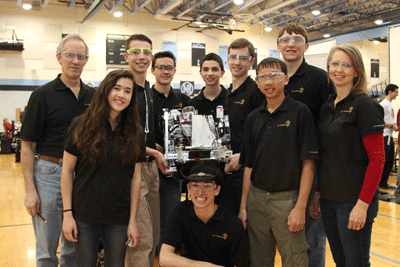 |
| The Synergists (left) and the Hawks (right). Go SynerHawks! |
We had our first round of competitions on Saturday. It was quite a long day at Coronado High School. It started at 7am and didn't stop until 6:30pm. The Synergists team that my son is on did very well. In fact they came in first place along with their Alliance partners, the Hawks who came from Roswell, NM.
FTC (First Tech Challenge) is such a different animal from FLL. I wanted to post some of the differences here so I could see a comparison:
1. FTC
costs more than FLL. Our first year cost about $1,000 total every year after that it cost $700-$800. FTC costs are now up to $4,000 for our first year and still going. On a positive note, companies are more apt to sponsor robots that look fancier.
2. Much more
emphasis is placed on the robot in FTC. Kids are drawn to the robot in both programs. However the add on of the Research Project in FLL makes it a little more well rounded depending on your point of view.
3. Both programs
allow the kids to build very capable robots using predefined parts. There was so much creativity in both programs. It so impressed me how you could build such a different looking robot and it would accomplish the same tasks.
4. FLL has more
missions. We could do upwards of 12 different missions in 2.5 minutes. FTC was more straightforward. We could do 3 - 5 missions, but that didn't make it necessarily easier. It was just that we didn't need to focus so much on all the different missions. There's more of a complexity to the building and programming of the FTC robots that makes up for the lack of need to focus on so many missions.
5. There may be more
strategy involved with FTC. Although you need some sort of game strategy for both programs, generally the robots in FLL are limited to working on their side of the table except for the shared mission that lies in between tables. At the FTC competition last week, we saw how strategy overcame a better robot design. One of the robots during the alliance rounds moved back and forth to block (but not too long as to be penalized) their opponent from making points. This actually worked because that robot was a great scorer.
6.
Temperamental. That was the word to describe the FLL Mindstorms robots during game time. Each time you had to line up your robots exactly right. Motors and tires would not work consistently because of battery or tire wear. Things just kept changing between each round. The only real way to have consistent runs was to make use of your sensors. With the Tetrix parts, we could get more consistency and during the teleop mode, the drivers had good control.
7. Both programs are s
upposed to be fun. For the younger crowd at FLL, that can venture into "goofing off". For the older crowd at FTC, they can venture into taking it too seriously and forgetting to have fun. Both need balance.



































